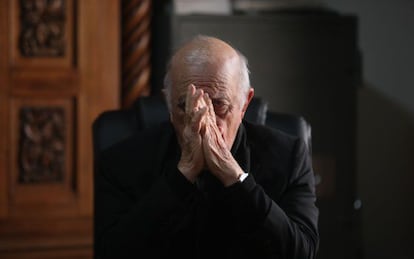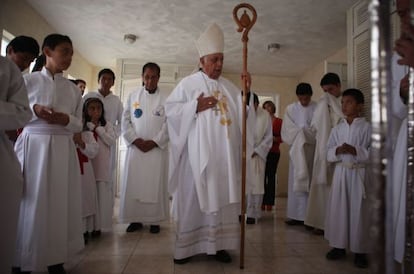The pope’s Mexican peacemaker
Francis I names Morelia archbishop Michoacán’s new cardinal


In 2013, Alberto Suárez Inda requested retirement from the Vatican. The Holy See promised to grant his request once it had found his successor as archbishop of Morelia, the capital of the Mexican state of Michoacán. In May 2014, Suárez Inda and members of his diocese visited Rome and Pope Francis told him: “Hold on for now. I don’t want you to get away.” Suárez Inda returned home. A while later, he received a notification ordering him to remain at his post donec aliter provideatur, or until other provisions are made.
On January 4, 2015, Suárez Inda was sleeping in the village where he planned to retire when a priest friend called him at 5am. “The pope has named you cardinal,” the friend said. The 75-year-old Suárez Inda told his friend that he was dreaming or perhaps having visions. But, soon after, he received an official telephone call from the Vatican confirming his friend’s message. “You cannot say yes or no,” Suárez Inda says in his office in Morelia on Thursday. “It simply falls on you like a flagstone.”
You cannot say yes or no. Being appointed cardinal simply falls on you like a flagstone” Archbishop Alberto Suárez Inda
The day the Vatican announced its 15 new cardinals, its spokesman Federico Lombardi explained why it had chosen the archbishop of Morelia: “Violence has dealt the region a heavy blow.” Suárez Inda will serve as Pope Francis’s mediator in the Mexican conflict.
Michoacán, a state where self-defense groups of armed civilians rose up in 2013 against drug-related crime, and Guerrero, where the Iguala massacre took place, are red dots on the Mexican map. Together they make up a top security priority in the south.
Suárez Inda will be in the Vatican on February 14 for his naming ceremony. He wants to visit the Catacomb of St. Callixtus to pray “where the first Christians were buried.” He says the pope’s favorite place in Rome is the San Luigi dei Francesi church where he always goes to meditate on the painting The Calling of Saint Matthew by Caravaggio, from which he took the motto printed on his episcopal coat of arms: Miserando atque eligendo – “by having mercy and by choosing.”
A few hours after the interview in his office, Suárez Inda calmly dons his robes to get ready to give mass in a church in a working-class neighborhood. As he prepares, he talks about the attire he will have to wear as cardinal. “Everything in red. They will say that I am a communist but it’s the red of martyrs, of those who are willing to bleed.”
“To help the pope,” another priest intervenes.
And Suárez Inda says: “To do whatever he asks. And whatever one is able to do.”

Suárez Inda is not a member of the faction of the Mexican Church with ties to the ruling Institutional Revolutionary Party (PRI). He is seen as someone more friendly with the Catholic center-right National Action Party (PAN), which his brother represented as former mayor of Celaya and to which former president Felipe Calderón belongs. Seated at the heart of the violence, independent from the federal government and with direct backing from the pope, the priest who wanted to retire is on the verge of becoming a key figure in the mediation process.
In the last month, there have been two bloody episodes in Michoacán. Eleven people died in mid-December in skirmishes between different self-defense groups, which were legalized as a rural security force last year. On January 6, nine people died during clashes between federal forces and a band of alleged criminals. According to official records updated in October 2014, there were at least 981 homicides in Michoacán last year and the state registered 916 murders in 2013.
Sitting in his office, dressed in black with a scarf and a silver cross on his chest, Suárez Inda speaks of how the violence affects the clergy. In December 2014, a priest was shot in the head. He was found dead on the border between Guerrero and Michoacán. Five priests have been murdered in the last 15 years, all of them in Apatzingán, the epicenter of the war between vigilantes and organized crime, he says. “One was by accident; another because he complained that they had introduced drugs on to his lands. Another because he advised the wife of a criminal to leave him.” Suárez Inda describes the region as a place where “everyone has high caliber firearms even bigger the military’s,” where it is not unusual for thieves to rob churches in the state capital. “They put a gun to your temple and they say: ‘I’m taking the computer and the chalice.’”
“Don’t run away yet,” the pope said. Suárez Inda considers the weight of the load it has fallen upon him to carry and says: “It’s one of Francis’s pranks.”
Translation: Dyane Jean François
Tu suscripción se está usando en otro dispositivo
¿Quieres añadir otro usuario a tu suscripción?
Si continúas leyendo en este dispositivo, no se podrá leer en el otro.
FlechaTu suscripción se está usando en otro dispositivo y solo puedes acceder a EL PAÍS desde un dispositivo a la vez.
Si quieres compartir tu cuenta, cambia tu suscripción a la modalidad Premium, así podrás añadir otro usuario. Cada uno accederá con su propia cuenta de email, lo que os permitirá personalizar vuestra experiencia en EL PAÍS.
En el caso de no saber quién está usando tu cuenta, te recomendamos cambiar tu contraseña aquí.
Si decides continuar compartiendo tu cuenta, este mensaje se mostrará en tu dispositivo y en el de la otra persona que está usando tu cuenta de forma indefinida, afectando a tu experiencia de lectura. Puedes consultar aquí los términos y condiciones de la suscripción digital.








































